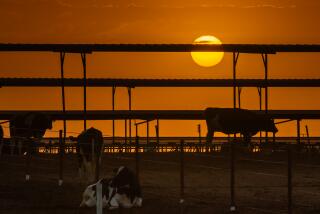Mysteries Under the Microscope : State Lab Studies Secrets of Killer Bees
- Share via
SACRAMENTO — While scientists comb the dusty terrain of Central California looking for missing swarms of killer bees, the real mystery is painstakingly unfolding in a suite of dingy offices overlooking the state Capitol.
This is the Department of Food and Agriculture’s laboratory--a maze of aluminum lockers, sample jars and cardboard boxes stacked to the ceiling.
One one side is a series of glass cases enclosing tiny insects impaled on pins. On another table, half a dozen bee legs have been removed and are awaiting analysis. In a nearby refrigerator, honeybee combs wrapped in plastic are flanked by bottles of cranberry juice and brown-bag lunches left by the lab’s scientific staff.
But this is much more than a museum of entomological curiosities. Here three scientists and two technicians carefully examine and dissect hundreds of bee samples collected near where a colony of ill-tempered Africanized honeybees was found last month.
Soon a mobile lab will be set up at the discovery site to help process thousands more samples that will be taken in the next 12 weeks in a stepped-up program ordered Wednesday to help isolate the alien bees from domestic species.
Measuring Tiny Parts
But for now, scientists here are poised over their microscopes, taking measurements of tiny bee parts--the only agreed-upon way of distinguishing Africanized bees from their domestic counterparts. The identification process is under way to determine whether the Africanized bees have invaded commercial beehives in the Central Valley.
Africanized bees are virtually indistinguishable from European varieties to the naked eye. Scientists in the field have been reduced to kicking commercial hives or pounding them with hammers to see whether the bees exhibit the aggressive characteristics typical of the Africanized insects.
In the laboratory, the scientific method is more precise, but even here, experts warn that they are dealing in a “vague area.”
“It’s like trying to tell an El Salvadoran from a Guatemalan,” said Fred Andrews, a entomologist who normally spends his time dealing with thousands of species of beetles.
The process is slow.
10 Given Further Testing
Out of every sample of 50 bees randomly collected from commercial hives, the laboratory picks 10 for further testing. Each must be dissected and carefully examined, first to determine whether the bee is carrying parasitic mites that could infest commercial bees.
Next, wings are carefully removed and mounted on glass slides for measurement. Africanized bees have wings slightly smaller than the domestic variety. About 90% of the bees are rejected because their wing size places them clearly in the European species. For the rest, the process becomes even more detailed.
Fine measurements must be taken of other body parts, including the legs and chest, and more detailed studies must be made of the wings. Andrews said that in some cases 47 separate measurements are made before work is completed on a single bee.
Even when scientists find a bee with the right measurements, that does not mean it is actually of the Africanized variety. Andrews said that there is great variation among all bees and that the only way to be sure is to contrast the measurements of large numbers of sample insects with measurements of large numbers of Africanized bees elsewhere in the world.
The process takes about four hours for each sample of 10, Andrews said.
1,000 Samples Examined
So far, about 1,000 samples have been examined this way. Scientists, including Andrews, still are not really sure about the findings, although there has been no positive identification of Africanized bees except those taken from the original underground hive.
“We do believe we had Africanized bees there,” Andrews said, “but the signals seem to be confusing. We’ve looked at the data but haven’t arrived at a consensus at what it is telling us.”
Earlier, scientists hoped to try a relatively new method of identifying the bees. The process, developed at the University of Florida, involves chemical analysis of the fatty substances covering bee bodies. It requires that the insects be mashed and the residue analyzed. Anita Collins, a U.S. Department of Agriculture geneticist and an expert on Africanized bees, said the test has proven less reliable than the standard measuring technique.
So for now, Andrews and his colleagues will continue their methodical detective work, knowing that all the answers may remain elusive.






